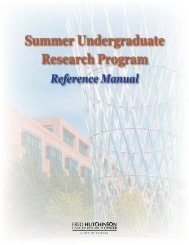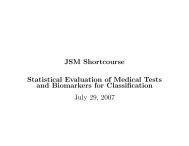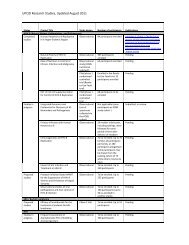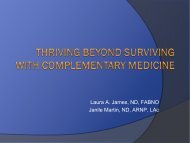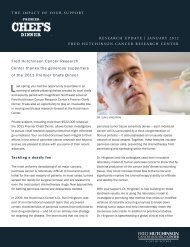discovery - Fred Hutchinson Cancer Research Center
discovery - Fred Hutchinson Cancer Research Center
discovery - Fred Hutchinson Cancer Research Center
You also want an ePaper? Increase the reach of your titles
YUMPU automatically turns print PDFs into web optimized ePapers that Google loves.
14<br />
Stanley Riddell, M.D.<br />
Immunotherapy <strong>Research</strong>er/Oncologist<br />
CANCER KILLERS WITH STAYING POWER<br />
In a perfect world, cancer doesn’t stand a chance of wreaking<br />
havoc. Like a soldier guarding the home shores, the<br />
immune system gives marching orders to a type of white blood<br />
cell known as T-cells to remain vigilant for an invasion of<br />
foreign cells, including cancerous ones. When a T-cell<br />
recognizes an invader, it initiates a process that targets that cell<br />
for destruction.<br />
But cancer is a formidable foe, one that<br />
Dr. Stanley Riddell is all too familiar with<br />
after more than two decades of waging<br />
war against it. “Tumors are very clever and<br />
they utilize evasion strategies to limit the<br />
effectiveness of the immune response,”<br />
he said.<br />
So he’s fortifying the immune system<br />
with better weapons: long-lived T-cells<br />
specially engineered to seek and destroy<br />
cancer.<br />
Through adoptive T-cell therapy,<br />
Riddell and his fellow researchers<br />
extract white blood cells from a cancer<br />
patient and expose them to proteins made<br />
in abundance by tumor cells. Scientists<br />
then identify the few T-cells that recognize the tumor proteins<br />
and stimulate those to divide, generating a billions-strong<br />
population of cancer-fighting cells that can be infused back into<br />
the patient. Ideally, this unique population of T-cells will find<br />
its way to the tumor site and annihilate the cancer cells.<br />
“When you see it work, it is so amazing—the bone marrow<br />
just goes from being full of leukemia to being in remission and<br />
very large tumors simply melt away,” Riddell said.<br />
T-cells, however, have a fatal flaw. They die quickly. And<br />
if an immune response isn’t sustained, cancer eventually<br />
comes back.<br />
Riddell and his colleagues knew immunity could last a<br />
lifetime—that’s how vaccines work. So the researchers reasoned<br />
that perhaps they were starting with the wrong T-cells.<br />
They began advanced testing on different<br />
types of T-cells and found that one<br />
type—central memory cells—had the<br />
staying power the scientists were seeking.<br />
They now had a sustainable starting point<br />
for cancer immunotherapy: T-cells with the<br />
capacity to survive.<br />
Riddell’s next step involves drawing<br />
blood samples from cancer patients, filtering<br />
out their central memory cells and<br />
engineering those cells with receptors to<br />
target tumors.<br />
The approach holds promise for fighting<br />
different types of leukemia, including<br />
chemotherapy-resistant acute lymphoblastic<br />
leukemia in children, and breast,<br />
ovarian and skin cancers. Riddell’s team’s insights may also<br />
strengthen the work of University of Washington researchers<br />
developing potential breast-cancer vaccines.<br />
“We’re really trying to move immunotherapy with central<br />
memory T-cells into the clinic quickly,” Riddell said. “We are<br />
excited by the potential for success and believe that this therapy<br />
can be applied to several types of cancer.”<br />
T-CELLS SWARM A CANCER CELL.




